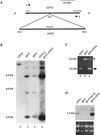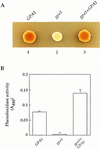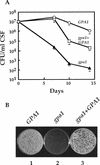Cryptococcus neoformans mating and virulence are regulated by the G-protein alpha subunit GPA1 and cAMP
- PMID: 9389652
- PMCID: PMC316752
- DOI: 10.1101/gad.11.23.3206
Cryptococcus neoformans mating and virulence are regulated by the G-protein alpha subunit GPA1 and cAMP
Abstract
This study explores signal transduction pathways that function during mating and infection in the opportunistic, human fungal pathogen Cryptococcus neoformans. The gene encoding a G-protein alpha subunit homolog, GPA1, was disrupted by homologous recombination. The gpa1 mutant strain was viable but exhibited a defect in mating in response to nitrogen starvation. Additionally, the gpa1 mutant strain failed to induce two well-established virulence factors-melanin synthesis, in response to glucose starvation; and capsule production, in response to iron limitation. As a consequence, virulence of the gpa1 mutant strain was significantly attenuated in an animal model of cryptococcal meningitis. Reintroduction of the wild-type GPA1 gene complemented the gpa1 mutant phenotypes and restored mating, melanin and capsule production, and virulence. Similarly, exogenous cAMP also suppressed the gpa1 mutant phenotypes, restoring mating and production of melanin and capsule. These observations support a model in which GPA1 has a role in sensing diverse environmental signals required for mating and virulence by regulating cAMP metabolism in C. neoformans.
Figures








References
-
- Blumer KJ, Johnson GL. Diversity in function and regulation of MAP kinase pathways. Trends Biosci. 1994;19:236–240. - PubMed
Publication types
MeSH terms
Substances
Grants and funding
LinkOut - more resources
Full Text Sources
Other Literature Sources
Molecular Biology Databases
Research Materials
